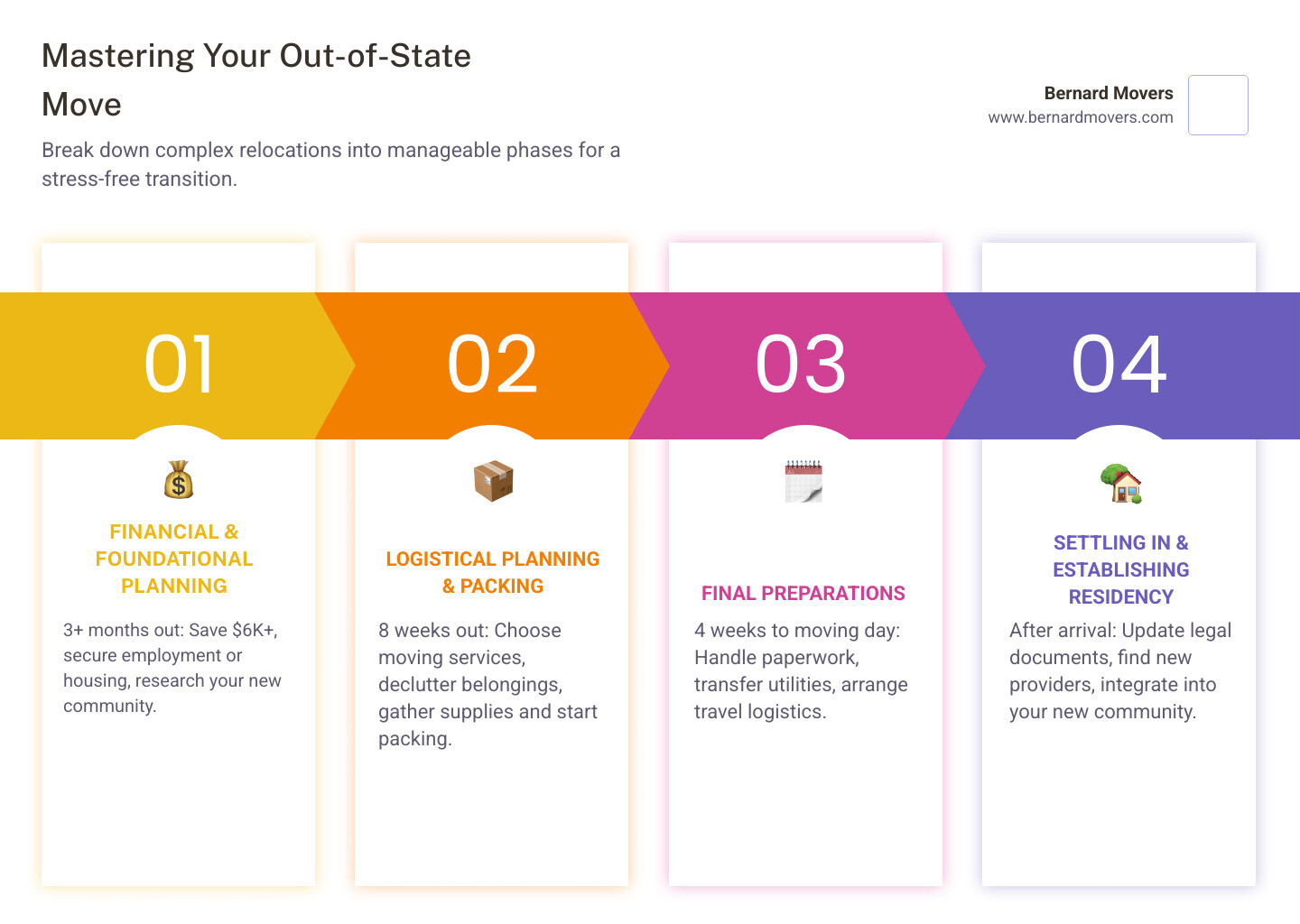Planning to move out of state: Your 4-Phase Ultimate Guide
Why Planning to Move Out of State Requires Early Preparation
Planning to move out of state involves more than packing boxes. Experts recommend starting the process at least 8 weeks in advance, as a successful interstate move requires careful financial and logistical planning. Many people underestimate the cost and complexity, with the average professional move costing around $4,890 for a 1,000-mile trip.
Key phases for planning an out-of-state move:
- Financial & Foundational Planning (3+ months out): Save for expenses, secure employment or housing, and research your new community.
- Logistical Planning & Packing (8 weeks out): Choose moving services, declutter, gather supplies, and start packing.
- Final Preparations (4 weeks to moving day): Handle paperwork, transfer utilities, and arrange travel.
- Settling In & Establishing Residency: Update documents, find new providers, and integrate into your community.
Moving can be stressful, but breaking it down into manageable phases makes it easier. I’m Mina Georgalas, owner of Bernard Movers. With nearly 30 years of experience, I know that early, systematic planning is the key to a smooth transition.

Glossary for planning to move out of state:
Phase 1: Financial and Foundational Planning (3+ Months Out)
Moving to a new state is a significant financial undertaking. Getting your finances and foundational plans in order early is the key to a smooth move. This phase is about building a strong base of information and financial readiness, from budgeting to researching your new community.

How Much Money Should I Save for an Out-of-State Move?
The cost of an out-of-state move is a major consideration. While experts suggest having at least $6,000 saved, a cushion of $10,000 is often recommended to cover unexpected costs and initial expenses. For those who want to find a job after moving, a fund of $20,000 provides greater flexibility.
Your budget should cover several key areas:
- Moving Costs: Hiring professional movers for a long-distance journey averages around $4,890 for a 1,000-mile trip, with costs for cross-country hauls ranging from $2,700 to $10,000 or more. Other options, like portable moving containers or truck rentals, have their own cost structures.
- Housing Expenses: Landlords typically require proof of income (2-3 times the monthly rent), a security deposit, and application fees.
- Travel Expenses: Factor in costs for your journey, such as gas, temporary lodging, and meals.
- Initial Living Expenses: You’ll need funds for utility setup, groceries, and other immediate needs upon arrival.
- Emergency Fund: If you are planning to move out of state without a job, having at least six months of living expenses saved is vital.
To understand your potential daily costs, use a cost-of-living calculator. For a deeper dive into financial preparation, see our guide on Budgeting for an Out-of-State Move.
The Big Question: Secure a Job or Housing First?
This is a classic dilemma when planning to move out of state. We advise securing a job first. Landlords almost always require proof of income and a solid credit score to approve a rental application. An offer letter from an employer serves as excellent proof of income, simplifying your housing search.
Many companies now use remote interviews, allowing you to job search from your current location. When you receive an offer, ask your new employer about relocation assistance to help offset costs. If you must move before securing a job, the financial cushion mentioned earlier becomes non-negotiable. You might consider temporary housing to give yourself time to find both a job and a permanent home. When you’re ready to look for a place, you can find homes in your new area with resources like Realtor.com.
Researching Your New Community from Afar
Before committing to a new state, do your homework to ensure it’s a good fit for your lifestyle. Here are key areas to explore:
- Climate and Weather: Are you prepared for the local seasons?
- Housing Market: How affordable are homes or rentals?
- Job Market: What are the major industries and typical salaries for your field?
- Schools: If you have children, research school systems and ratings. GreatSchools.org is a fantastic resource.
- Healthcare Quality: Are there sufficient medical facilities for your family’s needs?
- Crime Rates: Understand the safety of different neighborhoods.
- Culture and Lifestyle: Does the local vibe match your interests?
- Walkability and Amenities: Use tools like Walk Score and Google Maps to explore neighborhoods virtually.
Understanding these factors will help you make an informed decision and ensure a smoother transition.
Phase 2: The Ultimate Checklist for Planning to Move Out of State (8 Weeks Out)
With your foundational plan in place, it’s time to manage the logistics. The 8-week mark is when the action begins, focusing on choosing your moving method, decluttering, and starting to pack.

Choosing Your Moving Method
This decision significantly impacts your budget and stress levels when planning to move out of state. You have several options:
- Full-Service Professional Movers: This is the most hands-off option, as the company handles everything from packing to unloading. The average cost is around $4,890 for 1,000 miles. It offers insurance, experience, and speed. Book your long-distance moving company 8 to 12 weeks in advance, especially during peak seasons. Always verify your mover’s credentials through the Federal Motor Carrier Safety Administration (FMCSA) and review the required ‘Your Rights and Responsibilities When You Move’ booklet.
- Portable Moving Containers: This hybrid solution involves you packing a container that a company then transports to your destination. It can be a cost-efficient alternative to full-service moving.
- DIY Truck Rental: Renting a truck and handling the driving and labor yourself is often the cheapest method but requires the most effort.
- Vehicle Transport: If you need to ship your car, you may need a separate auto transport service, or you can choose to drive it yourself.
Consider the pros and cons of each based on your budget and timeline. For a detailed comparison, read our Essential Guide to Out-of-State Moving Options.
Decluttering and Downsizing Your Home
This step is critical for saving money. The less you move, the less it costs. Go through your belongings and decide what to sell, donate, or dispose of. Focus on items that are inexpensive to replace, are no longer used, or lack sentimental value. Getting rid of old appliances and outdated furniture can significantly reduce your moving weight and cost.
Gathering Supplies and Starting to Pack
Strategic packing can reduce stress. Start by gathering essential supplies like boxes, packing tape, bubble wrap, and markers. Create a clear labeling system for each box, noting its contents and destination room.
- Pack Non-Essentials First: Begin with items you use infrequently, like seasonal decor, books, and things from storage areas.
- Protect Fragile Items: Wrap breakables individually and pad boxes well. Take photos of electronic setups before unplugging them.
- Disassemble Furniture: Keep all hardware in labeled bags taped to the corresponding furniture piece.
- Prepare an Essentials Bag: Pack a suitcase with clothes, toiletries, medications, and important documents for the first few days in your new home.
For assistance with packing, loading, and even storage solutions, learn more about our Packing, Loading, and Storage Services.
Phase 3: Final Preparations and Logistics (4 Weeks to Moving Day)
The last month before your move is a busy time for handling final tasks. This is the final countdown where your careful planning to move out of state comes together.

Managing Essential Paperwork When Planning to Move Out of State
Organizing your documents is crucial. Create a “moving binder” or digital folder for all important papers. This should include your moving contract (Bill of Lading), estimates, and inventory lists. Also, gather personal identification (driver’s license, passports, Social Security cards), financial records, school transcripts, and pet vaccination records. Keep your new lease or home deed handy as proof of residency.
Be sure to forward your mail with the USPS and update your address with banks, credit card companies, and the IRS. Keep all moving-related receipts, as some expenses may be tax-deductible.
Arranging Utilities and Canceling Services
To avoid service interruptions, contact your current utility providers (electricity, gas, water, internet) to schedule disconnection for the day after you move out. At least two weeks before your move, contact companies in your new city to set up services for your arrival date.
Remember to cancel local memberships, such as gyms or clubs, and notify any regular service providers like gardeners or house cleaners. For more tips on getting organized, see our General Moving Tips.
Preparing for the Journey and Arrival
As moving day approaches, focus on your travel plans. If you’re driving, get your vehicle serviced and pack a roadside emergency kit. Book any necessary hotels in advance to secure better rates. Plan your driving route, allowing for regular breaks.
Pack an “essentials box” with items you’ll need immediately upon arrival, such as toilet paper, soap, towels, basic cleaning supplies, and bedding. This is separate from your personal go-bag and will be a lifesaver before you can fully unpack. For a complete list of tasks, consult our Out-of-State Moving Checklist.
Phase 4: Settling In and Becoming a Local
Congratulations! You’ve steered the complexities of planning to move out of state and have arrived at your new home. The hardest part is behind you. This phase is about turning your new house into a home and integrating into your community.
Your First Week in Your New Home
Tackling a few key tasks right away will help everyone settle in faster. After a final walkthrough of your old home, focus on your new space. Unpack your essentials box first, setting up beds and bathrooms. For safety, change the locks on all exterior doors and test the smoke alarms. This is also a good time to clean and inspect for any pre-existing damage. Finally, take a moment to introduce yourself to your new neighbors.
Officially Establishing Residency
It’s time to make your move official. Deadlines for these tasks vary by state. Prioritize getting a new driver’s license and registering your vehicle at the local DMV. You should also register to vote in your new district.
It is also important to:
- Find new healthcare providers and transfer your medical records. Resources like MyHealthfinder can help.
- Handle pet licensing and find a new veterinarian.
- Open a local bank account if needed.
- Familiarize yourself with state tax laws.
- Transfer any professional licenses to avoid work interruptions.
How to Integrate into Your New Community
Becoming part of the community takes time, so be patient with the process. Start by exploring your neighborhood, visiting local parks, and shopping at local stores. To meet people, consider joining clubs or groups that match your hobbies; websites like MeetUp.com are great for this. Volunteering is another excellent way to connect with others who share your values. Engage with neighbors, and if you have children, help them establish new routines to feel more secure.
Frequently Asked Questions about Planning to Move Out of State
What is the cheapest way to move out of state?
The most budget-friendly option when planning to move out of state typically involves handling much of the process yourself. A key way to save is to declutter significantly—the less you move, the less it costs. For transportation, DIY options like renting a moving truck or using a portable moving container where you do the packing and loading are generally cheaper than full-service movers. Selling unneeded items can also help fund your move.
How far in advance should I plan an out-of-state move?
For a smooth transition, we recommend you start planning to move out of state at least 8 to 12 weeks in advance. This timeframe provides enough room to research, budget, book moving services, and handle administrative tasks without a last-minute rush. If your move involves selling a home or finding a new job, you may need to start planning up to a year ahead.
What paperwork is most important for an interstate move?
Keeping your documents organized is critical. Before the move, secure your moving company contract (Bill of Lading), estimates, and inventory lists. Keep personal identification documents like your driver’s license, passports, Social Security cards, and birth certificates in a safe, accessible place. You will also need proof of your new residency (e.g., a lease or deed) to set up utilities and update your address.
Conclusion
While planning to move out of state can seem overwhelming, this guide provides a clear roadmap to success. The key is starting early and tackling the process one phase at a time. From financial planning to settling into your new community, each step builds toward a fresh start.
Unexpected hiccups can happen, but preparation is your best defense. By researching costs, choosing the right moving method, and handling administrative details in advance, you set yourself up for a smooth transition.
At Bernard Movers, we have nearly 30 years of experience helping families with their interstate relocations. We understand the challenges and are dedicated to making your move a success story.
Here’s something special for you: We’re offering a 20% additional discount on moves to Georgia and Florida booked for delivery by March 15, 2025. Whether you’re drawn to Georgia’s charm or Florida’s sunshine, we’d love to help make your transition seamless.
Ready to take the next step?
